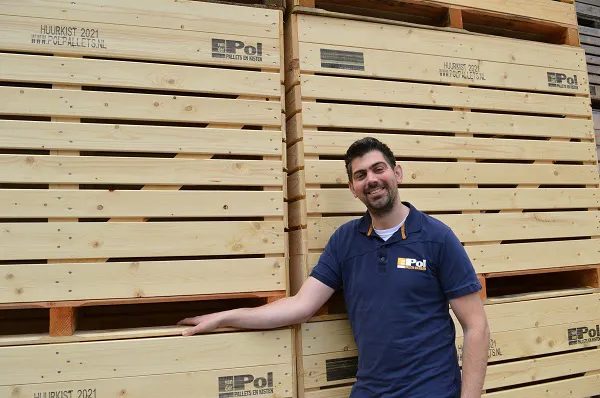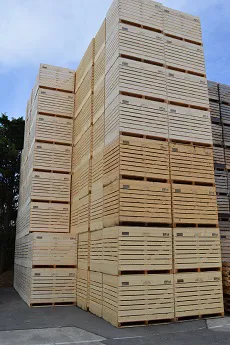Palletbedrijf van der Pol produces about 3,000 pallets and more than 200 crates every day. This Dutch company has invested quite a lot in automation in recent years. That's to keep costs low and productivity high. "Automation increases our staff's productivity. We focus on quality because that sells itself. And because we can keep costs low, we can achieve a good price-quality ratio," says Robert van der Pol.

Timber prices
There's a shortage of timber. These prices have, therefore, doubled in the past year. And steel prices have also risen sharply. "We think we're heading for a structurally higher price. If prices continue to rise at the current rate, wood prices are expected to quadruple this year. We use about a ton and a half of nails every single day. All this naturally affects pallet and crate prices. Prices aren't going to stabilize any time soon. And probably won't return to early 2021 levels either."
"It's becoming increasingly difficult to obtain timber. That's because China and America are buying up Northern European wood at high prices. There's also been a beetle infestation in Germany. A lot of wood was lost and can't be used for assembled products. Because they lost so much wood, Germany has decided to fell 15% fewer trees this year. In America, a newly developed construction technique is gaining popularity and increasing the demand for spruce," explains Robert.
"It's called Cross-Laminated Timber (CLT). Spruce lumber is cross-laminated, which makes it suitable for, say, wooden frame construction. This generally does wood prices no good. At the moment, sawmills determine daily timer prices, which could climb by the following day. And pallet demand is only rising. Here in Europe, the general rule is to produce one pallet per inhabitant per year."
Buyers' market transformed into sellers' market
The shortage in the timber market is causing changes in the buyer/seller positions. "It's usually a buyers' market. They decide what to buy, and sellers do their best to sell their products. It's reversed now - sellers decide who they want to sell to. That's because I can't now buy wood from another sawmill. So I can't buy more timber than I normally would. I, therefore, try to help my regular customers first. Only then can I take on new clients," says Robert.
Automation
The company has three manufacturing facilities. One is for pallets, the second for crates, and the third for special work. To distinguish themselves and keep costs down, Palletbedrijf van der Pol invests heavily in automation. The business got its first machine on the same day as its current owner Robert - January 6, 1987. "We've become highly automated, especially in the last 15 years."
"I'm an engineer, so I try to re-engineer and re-use lots of things. For example, we now have three people on our large automatic pallet manufacturing line. Together, they produce roughly 2,000 pallets a day. That's where a company's strength lies, producing more with fewer people. Pallet producers who don't commit to automation are also slowly disappearing. That's because it then becomes impossible to compete price-wise," Van der Pol continues.
 At the moment, the company is focusing on further automating its potato crate production. A crate seems to be a very simple product. But it has an enormous number of tolerances. If something's wrong somewhere, the whole crate is out of proportion and can, say, start to wobble. "That's exactly why I do much of the automation myself. We're familiar with the product. We know where the margins are and where to work very precisely. What's more, wood is a product that works, something that machine builders sometimes forget."
At the moment, the company is focusing on further automating its potato crate production. A crate seems to be a very simple product. But it has an enormous number of tolerances. If something's wrong somewhere, the whole crate is out of proportion and can, say, start to wobble. "That's exactly why I do much of the automation myself. We're familiar with the product. We know where the margins are and where to work very precisely. What's more, wood is a product that works, something that machine builders sometimes forget."
Local and international clients
Transporting crates and pallets wastes a lot of space. So, it's not viable to transport them over far distances. Van der Pol, therefore mainly delivers to companies in the region. To keep transport costs down, they do their own transport. They use a special trailer that's slightly larger. So, it can carry 52 crates instead of 32. Nevertheless, the company also has customers in Sudan, Israel, and Canada. They supply crates to these clients in construction kit form.
Specialization
Van der Pol's pallet production is fully automated. But, besides that, the company also has a drying area. There, wood is heated and, so, protected from living organisms that could affect the material. Before they process it into crates for, say, potatoes or onions, the timber is first planed. That removes any protruding splinters that could damage the products.
The waste wood goes to the company's own bio center, which generates power for the drying room. "Specialization and automation justify our existence. It puts us in a somewhat niche market, where there's actually almost no competition," concludes Robert. (MP)
Robert vab der Pol
robert@polpallets.nl
Palletbedrijf Van der Pol
Dorpsstraat 96
Woensdrecht
T(0)164 - 61 33 55
info@polpallets.nl
www.polpallets.nl
